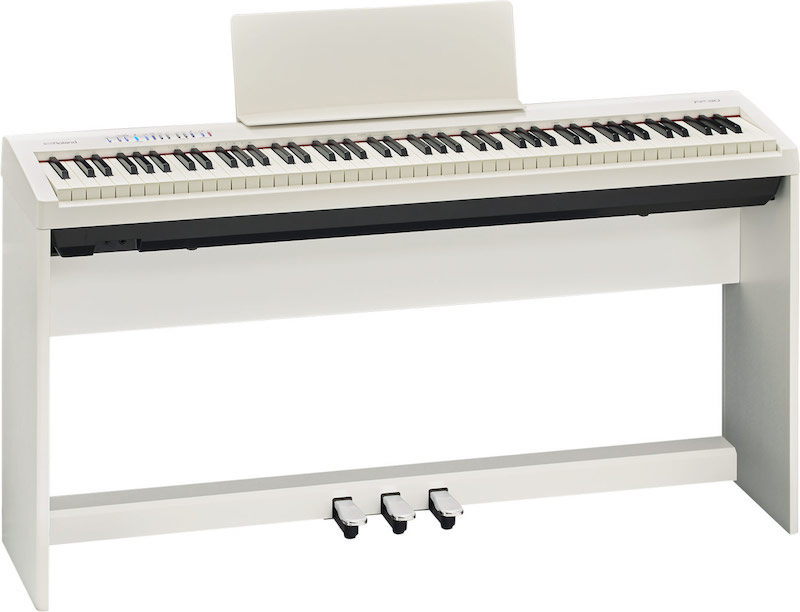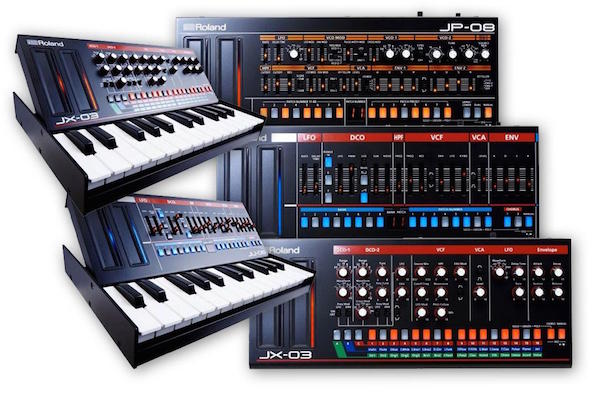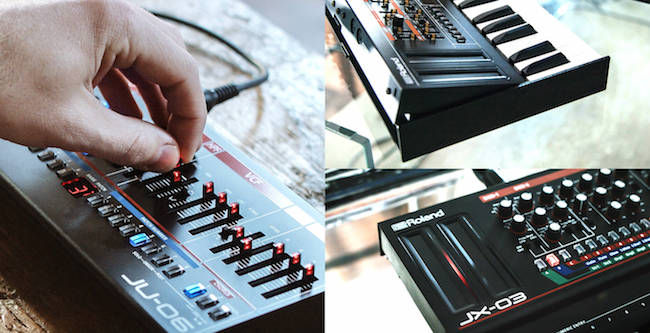Roland has successfully maintained its status as a heavyweight in the digital keyboard market over the past few decades. Ever since the 1980’s when watching my keyboard idols play behind “A” stands of keyboards emblazoned with the “Roland” name, I’ve had Roland products on my ever-evolving wishlist.
 Digital Pianos
Digital Pianos
Replicating a real, quality accoustic piano with a digital version seems to have been a goal that a lot of instrument manufacturers have pursued for years. Realism has gotten better every year, but it’s been the diminishing size, weight and price of digital pianos that have been a boon for musical consumers.
This year, Roland offers the FP-30, a compact and affordable instrument that brings Roland’s digital piano technology within reach of virtually everyone. The FP-30’s small footprint wil make it perfect for small spaces and very easy to transport in and out of the home, classroom or studio. Ideal for piano students, urban dwellers and young families, the instrument looks to be a great choice for performing musicians and music educators as well.
The FP-30 uses Roland’s SuperNATURAL® sound engine and incorporates a 88-note PHA-4 Standard keyboard, which inherits the progressive hammer action, escapement and Ivory Feel keys found in Roland’s high-end home pianos. This all combines to give you a grand piano experience in a much smaller package.
The FP-30 is equipped with speakers and dual headphones outputs which enable two people to listen at once. The outputs can alternately be used to connect to an external speaker system if desired.
 Additional sounds like strings, organs, voices and electric pianos let users broaden their musical experience, while dual and split functions allow two different sounds to be played at once. Onboard drum patterns enhance the enjoyment of everyday playing and offer an exciting alternative to the metronome while developing timing skills.
Additional sounds like strings, organs, voices and electric pianos let users broaden their musical experience, while dual and split functions allow two different sounds to be played at once. Onboard drum patterns enhance the enjoyment of everyday playing and offer an exciting alternative to the metronome while developing timing skills.
The FP-30 features built-in Bluetooth wireless capabilities, enabling users to explore using music apps for smartphones and tablets right at the piano. Popular apps like GarageBand and many others interact directly with the FP-30, creating a powerful, inspiring platform for learning, composing, and overall music fun. USB support is also included for playing along with favorite WAV/SMF tunes and sharing performances captured with the FP-30’s onboard SMF recorder.
The FP-30 is available in black or white. For a more traditional home piano setup, the optional KSC-70 stand and KPD-70 three-pedal unit provide an integrated look and classic pedal configuration while maintaining a much smaller footprint than a typical upright piano. When the KPD-70 is connected, one of its foot pedals can be used for hands-free turning of onscreen music pages while using popular mobile apps such as piaScore and Sheet Music Direct®.
 Bookshelf Synthesizers
Bookshelf Synthesizers
The Roland Boutique series is a new, limited-edition line of compact sound modules that recreate renowned analog synthesizers from the company’s past. The series includes three modules based on the JUPITER-8, JUNO-106 and JX-3P instruments from the 1980s. Each sound module can be used as a tabletop MIDI device or mounted in the companion K-25m Keyboard Unit to create a standalone compact synth.
Each Roland Boutique module is no bigger than a book and can run on USB bus power or batteries. The modules also include built-in speakers, a convenient feature for monitoring the sound in mobile environments.
JU-06 module has 23 parameters controllable via the front panel. Again, Roland claims to have replicated classic JUNO sound, complete with the original’s signature chorus effect. New enhancements include a faster LFO and continuously variable high-pass filter.
 The JX-03 module models the JX-3P synth. While the original featured a button-driven interface for immediate access to preset sounds, it was highly programmable when paired with the optional PG-200 controller. The four-voice JX-03 inherits all 24 knobs from the PG-200 and has added extras not present in the original synth include new waveforms, expanded DCO range, and cross-modulation options.
The JX-03 module models the JX-3P synth. While the original featured a button-driven interface for immediate access to preset sounds, it was highly programmable when paired with the optional PG-200 controller. The four-voice JX-03 inherits all 24 knobs from the PG-200 and has added extras not present in the original synth include new waveforms, expanded DCO range, and cross-modulation options. With the optional K-25m Keyboard Unit, users have the ability to turn a Roland Boutique module into a compact, all-in-one synth with 25 velocity-sensitive keys. Each module mounts in the K-25m quickly and easily, and can be interchanged with another in no time. Once in the K-25m, the module can be mounted flat or angled in two different positions for easier access to the panel controls.
With the optional K-25m Keyboard Unit, users have the ability to turn a Roland Boutique module into a compact, all-in-one synth with 25 velocity-sensitive keys. Each module mounts in the K-25m quickly and easily, and can be interchanged with another in no time. Once in the K-25m, the module can be mounted flat or angled in two different positions for easier access to the panel controls.



